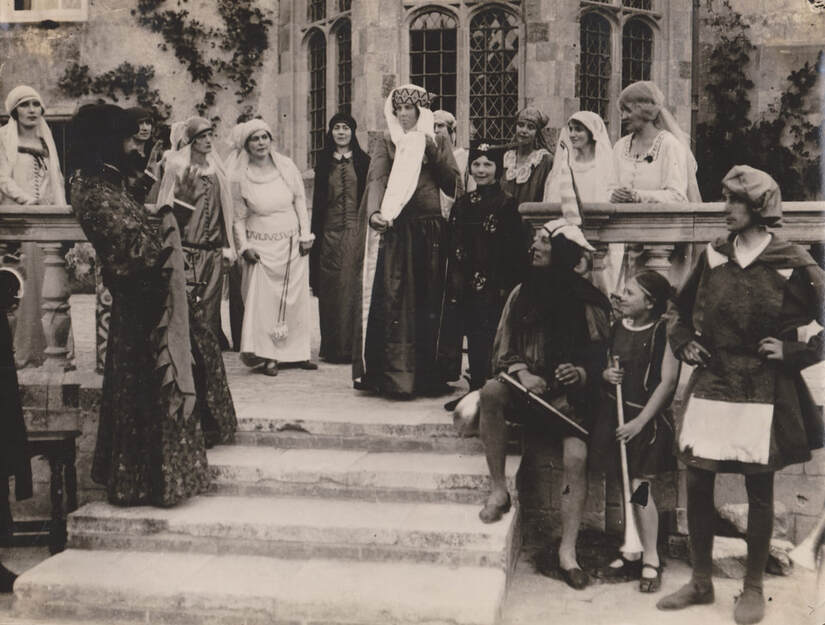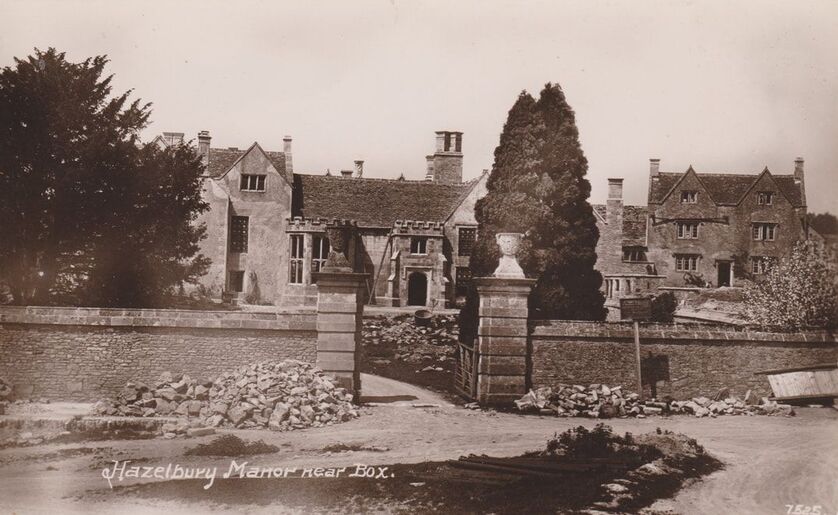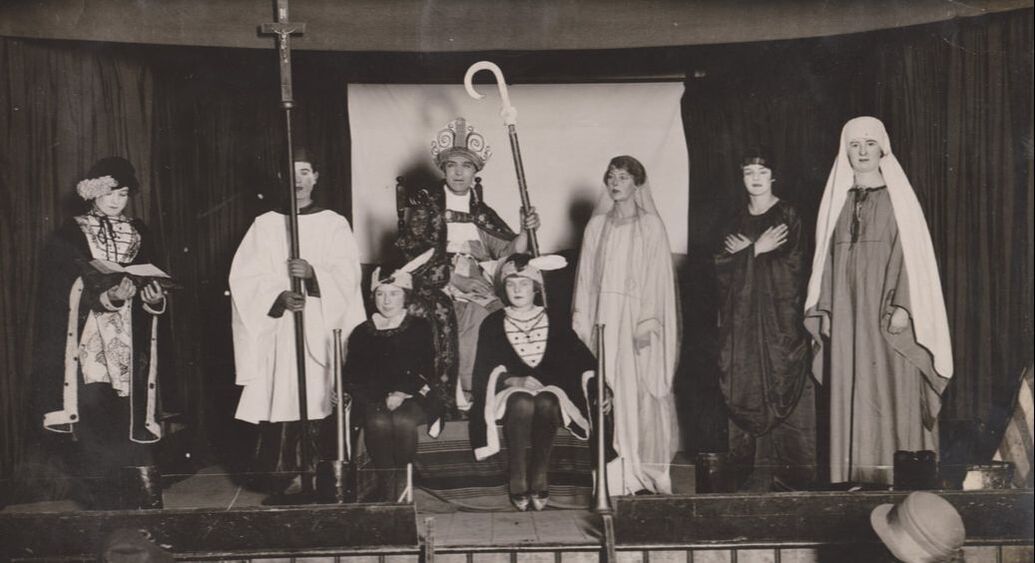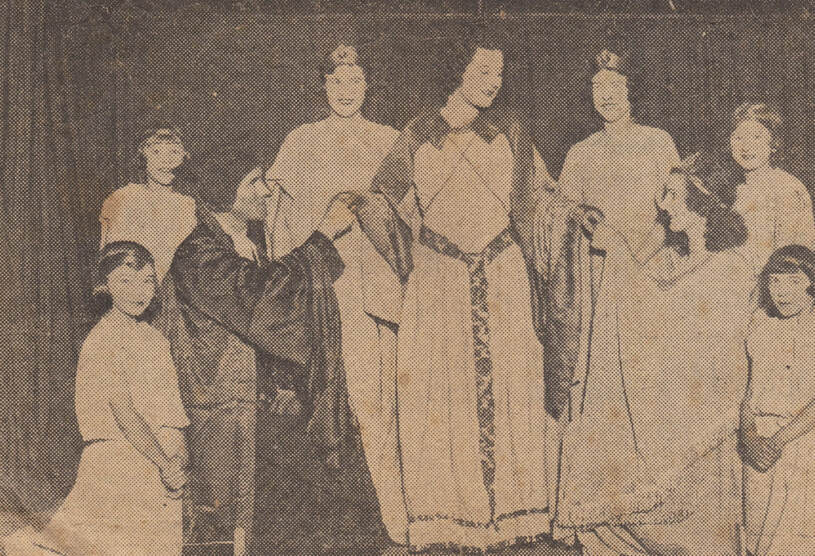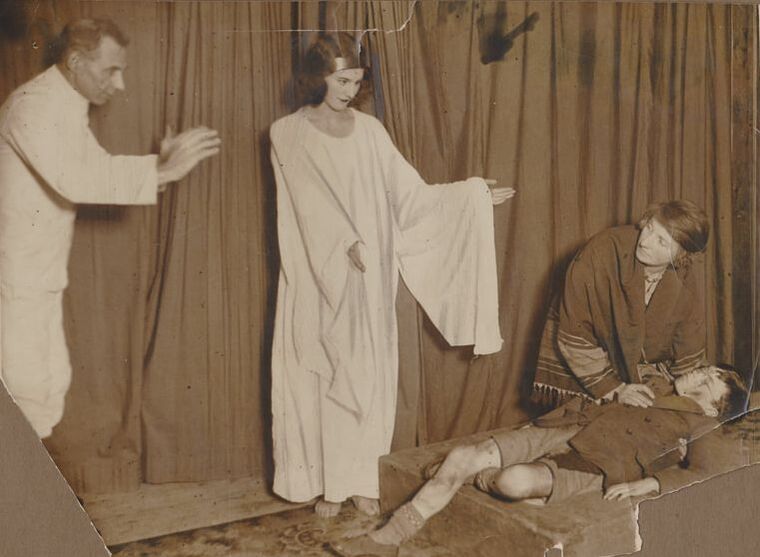Discovering the Past Alan Payne March 2022
Previous generations viewed their history in different ways. The Georgians were keen to rebuild in classical style and the Victorians forged a new history with technology and imperial prowess. By 1920, the situation had changed with more emphasis on documentary evidence and finding the origin of names and locations. The local initiative was led by some eminent Box people: GJ Kidston (owner of Hazelbury Manor who recorded a history of his house and area), Alfred Shaw Mellor (owner of Box House who transcribed extracts of the parish registers), Henry Druett (headmaster of Box Schools who recorded details in the parish magazine) and vicar Rev George Foster and his wife Kate (who wrote and produced theatrical reconstructions of the past).
Saving the Past at Hazelbury Manor
Saving the Past at Hazelbury Manor
George Jardine Kidston bought the Hazelbury Manor in 1919 when the Northey family was seeking to reduce its landholdings after the First World War. It was in poor condition, a run-down farmhouse in need of urgent repair, described as sunk to farm level, but even as such it was enticing.[1] George Kidston began extensive work stripping back Victorian plasterwork to reveal the older features in the medieval hall and restoring original chimneys, fireplaces and Tudor windows. He rebuilt whole sections on the south terrace with the assistance of the local architect, Sir Harold Brakspear. The postcard shows some of the work in progress including the restoration of one Grecian urn.
The scale of the improvements were an enormous cost and required fundamental alterations, such as the installation of electricity, water and sewage and the modernisation of cooking, heating and domestic infrastructure. All of this contrasted markedly with the houses of less wealthy Box residents, most of whose properties lacked basic necessities until after the Second World War.
The scale of the improvements were an enormous cost and required fundamental alterations, such as the installation of electricity, water and sewage and the modernisation of cooking, heating and domestic infrastructure. All of this contrasted markedly with the houses of less wealthy Box residents, most of whose properties lacked basic necessities until after the Second World War.
History Recreated
To celebrate the completion of the building work, George Kidston opened the grounds for selected charitable events and in July 1925, with the Rev George Foster and the Hon Mrs Dora Shaw Mellor, he put on a Pageant at Hazelbury which they called Box Fete and Historical Pageant to raise funds for improvements at Box Church and the Bingham Hall. A series of processions and tableaux (static representations of the past) were enacted to show episodes in Box’s story: Roman Box; St Aldhelm’s Discovery of Box Stone; Fourteenth Century Hazelbury; Chapel Plaister; and the story of Box Revels. Performances included those outdoors at Hazelbury and indoors at the Bingham Hall.
We might consider that silent tableaux without words or plot was rather unexciting in our age of television, colour photography and action movies. From a social point of view, however, it encouraged people to devise their own costumes and was greatly unifying at a time of severe unemployment. Afterwards Rev George Foster could talk of costumes that had been donated: two sets of charming folk-dance dresses, a set of Monk’s cowls, and set of slave-girl dresses.[2] It was obviously thoroughly enjoyed as can be seen from the headline photograph.
It wasn’t just George Kidston’s history of Hazelbury that excited villagers about Box’s historic past. In 1922 Henry Arthur Druett took over as headmaster of the Box Schools and indulged his passion for local history with a series of articles in the Parish Magazine after his appointment as editor about 1927. Along with Arthur Shaw Mellor, they started to publish extracts of the Box Parish Registers and articles about Box Church, Middlehill Spa, and the 1897 School Clock - to name but a few.[3] The recording of the origin of the names of various Box locations was another of their achievements which lasted throughout the 1930s.[4]
To celebrate the completion of the building work, George Kidston opened the grounds for selected charitable events and in July 1925, with the Rev George Foster and the Hon Mrs Dora Shaw Mellor, he put on a Pageant at Hazelbury which they called Box Fete and Historical Pageant to raise funds for improvements at Box Church and the Bingham Hall. A series of processions and tableaux (static representations of the past) were enacted to show episodes in Box’s story: Roman Box; St Aldhelm’s Discovery of Box Stone; Fourteenth Century Hazelbury; Chapel Plaister; and the story of Box Revels. Performances included those outdoors at Hazelbury and indoors at the Bingham Hall.
We might consider that silent tableaux without words or plot was rather unexciting in our age of television, colour photography and action movies. From a social point of view, however, it encouraged people to devise their own costumes and was greatly unifying at a time of severe unemployment. Afterwards Rev George Foster could talk of costumes that had been donated: two sets of charming folk-dance dresses, a set of Monk’s cowls, and set of slave-girl dresses.[2] It was obviously thoroughly enjoyed as can be seen from the headline photograph.
It wasn’t just George Kidston’s history of Hazelbury that excited villagers about Box’s historic past. In 1922 Henry Arthur Druett took over as headmaster of the Box Schools and indulged his passion for local history with a series of articles in the Parish Magazine after his appointment as editor about 1927. Along with Arthur Shaw Mellor, they started to publish extracts of the Box Parish Registers and articles about Box Church, Middlehill Spa, and the 1897 School Clock - to name but a few.[3] The recording of the origin of the names of various Box locations was another of their achievements which lasted throughout the 1930s.[4]
Traditional English Culture
We might think nowadays that some of the culture being extolled was rather fanciful, such as sending a group of children from Box to compete in the Devizes County Festival in sword-dancing in 1926.[5] In April the Devizes results were known: the school choir won a shield for sight singing English tunes, the folkdance team won a first-class certificate with 2 gold stars and the sword dance teams certificates with 1 gold star. The 1920s and 30s saw an attempt to define and capture a national ideal of an Anglo-Saxon English past. The newly-formed company of Box Girl Guides and the re-formed Box Scouts played a part in educating and shaping young minds.
An interest in broader English folk traditions was led by Arthur’s wife, the Hon Mrs Dora Shaw Mellor of Box House. Formed in 1932, the national society was a merger of the Folk-Song Society and the English Folk Dance Society and was based at Cecil Sharp House, Camden, London. Along with Charles and John Morley, Mrs Shaw Mellor ran the Box branch of the English Folk Dance and Song Society during the 1930s organising folk evenings and parties. In 1933 Box was putting on Folk Dance classes in the Bingham Hall and a Folk Dance party.[6] Thirty dancers came from Bath and twenty from Trowbridge and the event made £4.10s split between the Nursing Association and the club’s funds.[7]
Influence of the Church
The days of High Victorian ecclesiastical devotion had gone by the 1920s but the church still led the initiative to discover history, much of it depicting Biblical stories. The Rev George Foster and his wife Kate produced, wrote and directed a dozen plays depicting Bible scenes. The shows started in 1925 with an Easter Passion Play called The Only Son and continued that Christmas with a mystery called The Stranger. Some reviews were more light-hearted such as Rubbish, Some Rubbish and More Rubbish (1925 and 1926) which often featured the vicar in revues, recitals and sketches, often presenting himself in a self-deprecating manner.
We might think nowadays that some of the culture being extolled was rather fanciful, such as sending a group of children from Box to compete in the Devizes County Festival in sword-dancing in 1926.[5] In April the Devizes results were known: the school choir won a shield for sight singing English tunes, the folkdance team won a first-class certificate with 2 gold stars and the sword dance teams certificates with 1 gold star. The 1920s and 30s saw an attempt to define and capture a national ideal of an Anglo-Saxon English past. The newly-formed company of Box Girl Guides and the re-formed Box Scouts played a part in educating and shaping young minds.
An interest in broader English folk traditions was led by Arthur’s wife, the Hon Mrs Dora Shaw Mellor of Box House. Formed in 1932, the national society was a merger of the Folk-Song Society and the English Folk Dance Society and was based at Cecil Sharp House, Camden, London. Along with Charles and John Morley, Mrs Shaw Mellor ran the Box branch of the English Folk Dance and Song Society during the 1930s organising folk evenings and parties. In 1933 Box was putting on Folk Dance classes in the Bingham Hall and a Folk Dance party.[6] Thirty dancers came from Bath and twenty from Trowbridge and the event made £4.10s split between the Nursing Association and the club’s funds.[7]
Influence of the Church
The days of High Victorian ecclesiastical devotion had gone by the 1920s but the church still led the initiative to discover history, much of it depicting Biblical stories. The Rev George Foster and his wife Kate produced, wrote and directed a dozen plays depicting Bible scenes. The shows started in 1925 with an Easter Passion Play called The Only Son and continued that Christmas with a mystery called The Stranger. Some reviews were more light-hearted such as Rubbish, Some Rubbish and More Rubbish (1925 and 1926) which often featured the vicar in revues, recitals and sketches, often presenting himself in a self-deprecating manner.
In 1927 the usual Good Friday Service was replaced with a Passion Play, Through the Ages, charting episodes from the first Good Friday, St Gregory in a slave market and the vision of Joseph of Arimathea.[8] It attracted an audience of over a thousand over several nights in the Bingham Hall. By the 1930s more ambitious productions included The Church Army (1930) and The Way of Compassion (1931) both performed by the Box Church Players' Guild (local amateur dramatic enthusiasts) in the Bingham Hall.
The photograph below is of another of the plays by George and Kate Foster. Through the Ages Passion Play in the Bingham Hall depicted angels solicitous about the health of a child. It features James Browning on the left of the picture, possibly the scene reconstructed the story of Lord Shaftesbury and the Children. The seventh Earl of Shaftesbury (the Poor Man's Earl) was renowned for his work to reform institutions for the insane and to limit the working day for factory children. He founded the Ragged School Union promoting education for poor children. He died in 1885 and eight years later a statue in his honour was installed in Piccadilly Square, London, called The Angel of Christian Charity, which has unfortunately has become wrongly-known as the statue of Eros.
Conclusion
In July 1930, the parish magazine tried to piece together the history of St Thomas à Becket Church. It recorded: On St Thomas’ Day (July 7th) it was customary for the people to meet in Box Church and then march in solemn procession to St Thomas’ well, which was in front of the present mortuary (Gael Cottage) on the Bath Road near the Bear Hotel. Afterwards they indulged in games and other forms of jollity. Becket’s well was an object of pilgrimage. This is all rather vague and undated but it was a considerable improvement on earlier efforts to record Box's history.
In July 1930, the parish magazine tried to piece together the history of St Thomas à Becket Church. It recorded: On St Thomas’ Day (July 7th) it was customary for the people to meet in Box Church and then march in solemn procession to St Thomas’ well, which was in front of the present mortuary (Gael Cottage) on the Bath Road near the Bear Hotel. Afterwards they indulged in games and other forms of jollity. Becket’s well was an object of pilgrimage. This is all rather vague and undated but it was a considerable improvement on earlier efforts to record Box's history.
Much of the debate about history before the 1920s and 30s involved anecdotal stories of heroes (usually white, male and Christian) and the efforts of Victorian archaeologists to find the origins of prehistoric sites and to date village churches. There was little attempt to explain our social, cultural or topographical origins. It was the work of Professor WG Hoskins at Leicester University who developed local history in his pioneering book The Making of the English Landscape published in 1955 and EP Thompson in the Open University classic, The Making of the English Working Class in 1963 If you are interested in the subject, borrow a copy of these books from the library, very well worthwhile.
References
[1] Hazelbury Manor, Wiltshire reviewed in English Homes magazine
[2] Parish Magazine, August 1925
[3] Parish Magazine, February 1929, February 1930, and June, July and August 1930
[4] Parish Magazine, December 1933
[5] Parish Magazine, April 1926
[6] Parish Magazine, August 1933
[7] Parish Magazine, December 1933
[8] Bath Chronicle and Herald, 23 April 1927
[1] Hazelbury Manor, Wiltshire reviewed in English Homes magazine
[2] Parish Magazine, August 1925
[3] Parish Magazine, February 1929, February 1930, and June, July and August 1930
[4] Parish Magazine, December 1933
[5] Parish Magazine, April 1926
[6] Parish Magazine, August 1933
[7] Parish Magazine, December 1933
[8] Bath Chronicle and Herald, 23 April 1927
